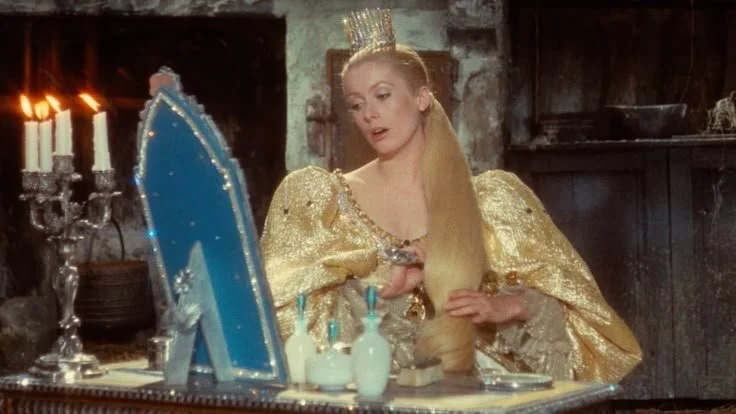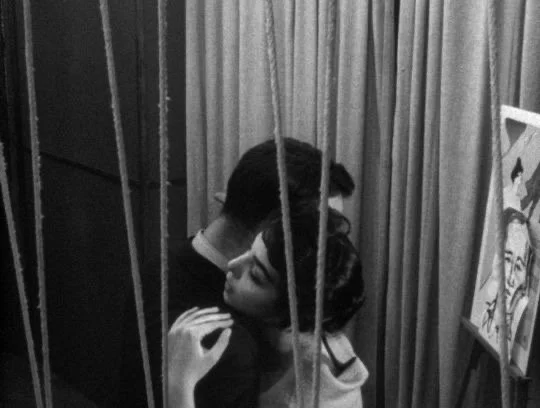City Lights: Love & Class
BY GENEVIEVE BLYTHE“I think romance is an approach to make life interesting and noble and beautiful…I say that [without romance] life can be a very horrifying and frightening thing”
Pathos – the word always thrown around when speaking of Chaplin’s films. Yet it is impossible to speak of them without acknowledging it. City Lights is brilliant for the way in which it threads social commentary, romance, and comedy together, all without feeling forced. Chaplin accomplishes this feat of balancing through his signature sense of sentiment and pathos, infusing the Tramp with a humility that both makes our hearts swell and gives us a laugh.
The Tramp is a disruption to bourgeois life – asleep in the arms of the figure of Prosperity, and causing mayhem amid the crowds of the Millionaire’s associates. His own value of and attitude towards money and so-called prosperity fall out of line with that of the bourgeois. He is quick and eager to give any money he receives to the Blind Girl whom he is instantly smitten with. Love overcomes the importance of economic circumstance. Completely unconcerned with his own situation, he allows this childlike and humble love to guide his efforts.
Even still, the bourgeois attitude remains pervasive. The Blind Girl believes him to be wealthy and the Tramp keeps the ruse up to continue seeing and aiding her, her lack of sight the sole reason the Tramp can inhabit this necessary role. The Billionaire only welcomes the Tramp into his life when he is completely inebriated, his own form of blindness. The moment he sees the Tramp the morning after in the sober daylight he kicks him out of his presence.
Despite it all, Chaplin ends on a beautifully optimistic note. The Blind Girl can see and the Tramp has stumbled upon her once again. The realization dawns upon her and she smiles. Both Chaplin and Virgina Cherrill give incredibly heartfelt performances in the final scene, lending even more height to the romance grounded in the supreme simplicity of the phrase “You can see now?”. Perhaps love really can overcome economics. It will bring a tear to even the driest eyes. It certainly did to mine.
Why City Lights?
FOUR REASONS WE CHOSE TO FEATURE THIS FILM IN OUR APRIL ISSUEStanley Kubrick, Andrei Tarkovsky & Orson Welles have cited City Lights among their favorite films
A Silent Film in the Sound Era – By 1931, “talkies” had taken over Hollywood, but Chaplin stubbornly stuck to silent film techniques, believing they had more universal appeal. His gamble paid off— City Lights was a massive hit!
Chaplin himself considered City Lights his greatest film, even over Modern Times and The Great
Dictator. It blends slapstick comedy with deep emotional resonance, making it a timeless classic.
When City Lights premiered in Los Angeles, Albert Einstein was in the audience and reportedly loved the film. Imagine watching a Chaplin classic sitting next to one of the greatest minds in history!
Extra Credit
FILMS WE’VE BEEN LOVINGBERNICE BOBS
HER HAIR (1976)
Shelley Duvall STUNS in this adaptation of F. Scott Fitzgerald’s short story. Director Joan Micklin Silver captures girlhood with a keen understanding— simple, fun, and effortlessly charming.
SHEA’S CHOICE
CHOOSE ME
(1984)
Neon lights, cigarette smoke, a sex radio therapist, a French gangster, jazzy score, erotic tension, characters who are real humans — need I say more?
GENEVIEVE’S CHOICE
THE LAST
PICTURE SHOW
(1971)
New Hollywood’s take on Old Hollywood—set in a conservative Texas town, filled with sex, drinking, and a whole lot of Hank Williams. Starring a young Jeff Bridges and the girl next door, Cybill Shepherd.
JESSE’S CHOICE
How to Seduce a Cinephile
Show Consistency.
Have your prime cinema spot chosen and head directly to it every time — even foregoing popcorn for that sweet aisle seat in the fifth row.
Make the Time.
Don’t show up right before the screening begins — arrive at least half an hour early so they know you’re serious.
Assert Boundaries.
If someone near you is being disruptive, don’t be afraid to call them out or even shush them — it’ll show how much you really care.
Think Ahead.
Plan ahead — make sure you use the restroom before the screening as to limit disruptions to the immersive experience.
Silence Can Be Intoxicating.
Sometimes, a lingering glance or an unspoken moment says more than words.
Communicate.
But for the love of God(ard) not during the film.
Use Sound Design Wisely.
The way you speak—your tone, your pauses— can be as seductive as the words themselves.
Don’t Rush.
Take a beat to let the film wash over you when it’s finished instead of rushing out of the cinema right away.
Extra Credit
ANSWERS AT BOTTOM OF PAGE
The Fine-r Side of Life
by J.G. FINEDon’t Be Afraid To Enjoy What You See
I’ve been watching life pass by. I’ve seen daphnes wilt and bloom and their aroma disappear into the wind. I’ve seen hailstorms erupt while my eyes were closed and the sun smiling when I opened them back up. I’ve seen Nicole Kidman drink a glass of milk in an upscale bar and I’ve seen The Man With No Name bluffing his way through the Pigeon Toed Orange Peel. I’ve seen things that you’ve seen and you’ve seen things that I haven’t seen, and that’s alright, maybe we can have a coffee and exchange war stories sometimes. Speaking of war stories, what was the last war film you saw? Does Casablanca count? What about Star Wars, there’s the literal “war” in the title. What about the war against physical media? Why can’t I go into a Target and buy a Blu-Ray with my good looks? I think Abraham Lincoln said that, I’ll have to check in with Daniel-Day and Henry Fonda. I count the days by the films I’ve seen, my calendar is nothing but movie stubs and one-off dates, situationships that are built off romcoms and playboy magazines, and bars, lots of bars. Guiness, Rainers, Old Fashioneds, Extra Dirty Martinis, soda water, bitters and limes and friends, lots of friends.
Community is what makes life pass by slowly and quickly at the same time. Gather your loved ones and put an X on the calendar and go see a movie, and talk about it afterwards over cheap cheeseburgers and Miller High Lifes, because even though you’re watching life pass by, don’t be afraid to enjoy what you see.
Adventures in Moviegoing
Adventures in Moviegoing is a section where the three of us document our shared moviegoing experiences through various mediums, exploring the different ways a film can inspire.Old Joy
BY GENEVIEVE BLYTHEScreenwriter Jonathan Raymond described Old Joy as a fragile, beautiful film in an interview after the screening on February 6th. The film certainly is full of fragility, both between the central characters and within the atmosphere Reichardt constructs.
Centered around Kurt and Mark, the film delves into that moment when you realize you must accept you’re a real adult (or in some cases reject such a notion). The film opens on Mark, with his meditation routine and pregnant wife. He’s settled and clearly moving towards the future with an objective. Enter a call from Kurt, a seemingly former good friend who happens to be in town and wants to visit some hot springs with Mark. Kurt’s nomadic lifestyle is apparent from the get-go, from the van he grabs his belongings from to his disheveled look. He’s unrooted, void of the ties Mark has found for himself. A dichotomy set up from the start.
A sense of history runs through the relationship of Kurt and Mark, the weight of years gone by. Both seem unsure about the choices they have made that led them to their current position, at least slightly dissatisfied with what each has sacrificed for their lifestyle. Mark’s stoicism belies a loss of freedom, a hint of longing for the rootlessness Kurt has given himself over to. Yet, he pretends that this feeling isn’t present, buries it within himself to perhaps never be examined. Kurt is forward with the fact that he is somewhat jealous of the life Mark has built for himself, of the roots he has planted that will only continue to grow. Kurt alternatively gives voice to the tension between the two men, to the distance that obviously has grown between them, a tension Mark quickly waves away, unwilling or unable to confront their position.
Each represents a desire present in varying degrees in all of us – a desire for freedom and a desire for stability. The question becomes which is stronger within you, and are you willing to make and accept the sacrifices necessary to move towards that pole. Both Mark and Kurt’s answers to these questions seem they could unravel at the slightest pressure.
This tension and interiority is not only achieved through the grounded performances of Daniel London and Will Oldham, but through the natural approach Reichardt brings to the photography and pace of the film. She never cuts a scene too early, populating the film with pauses and ellipses, leaving plenty of space to sit with feelings and sensations. She intuitively understands the power of nature, its majesty over us, and captures it in such a way that this power is never forgotten, exemplified even. Moments of personal reflection intercut with the sounds and images of Oregon’s forests. It seems Mark and Kurt are the only people on Earth when they’re out there, that the tenuous connection between them could be immediately severed by even just the sight of another being. The hot springs acting as a sanctuary for Kurt to declare that “sorrow is nothing but worn out joy” before they must return to the city and their perhaps worn out lives.
It’s hard not to be biased about a film that captures the city you live in with such care and transforms it into a poetic vision that is within your reach. And I don’t believe it’s really worth trying.
What is Film School
FILM SCHOOL was founded by three friends united by their love of cinema and a desire to build a community for like-minded individuals to watch, discuss, and connect through film.
Blow Up (1966)
Mulholland Dr (2001)
Donkey Skin (1970)
Inauguration of the Pleasure Dome (1954)
Shadows (1959)
Symbiopsychotaxiplasm (1968)
















